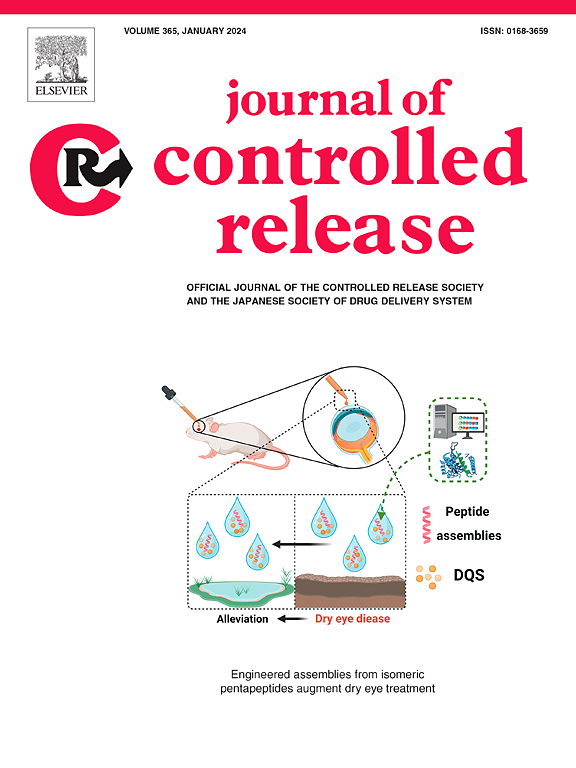ATRA derived lipid nanoparticles for co-delivery of siCYP26A1 to overcome metabolic limitations of differentiation therapy in solid tumors
IF 10.5
1区 医学
Q1 CHEMISTRY, MULTIDISCIPLINARY
引用次数: 0
Abstract
All-trans retinoic acid (ATRA) effectively treats acute promyelocytic leukemia but struggles in solid tumors due to insufficient tumor accumulation from poor targeting delivery and rapid metabolism by cytochrome P450 enzymes (particularly CYP26A1). Herein, we developed a lipoplex with a folic acid (F), utilizing ATRA-derived lipid nanoparticles (RA) for co-delivery of ATRA and siCYP26A1 (FRA/siCYP26A1). As the ATRA could upregulate the folate receptor β (FRβ), the endocytosis of FRA/siCYP26A1 could be consistently promoted. After FRA/siCYP26A1 treatment, the intracellular concentration of ATRA reached up to 10-fold higher than the clinically used 13-cis-retinoic acid (13-cisRA) and free ATRA. The efficient differentiation was reflected by the expression of differentiation markers peaking up to an order of magnitude higher than free ATRA and a remarkable change in cell morphology. Finally, the FRA/siCYP26A1 significantly suppressed neuroblastoma xenografts by 90.2 % and orthotopic hepatocellular carcinoma by 77.4 %. The present study, for the first time, showcased the potential of co-delivering ATRA and siRNA as a therapeutic approach to govern the concentration of ATRA in tumors and thus facilitate differentiation therapy for solid tumor treatment.

ATRA衍生的脂质纳米颗粒用于共递送siCYP26A1以克服实体肿瘤分化治疗的代谢限制
全反式维甲酸(ATRA)可有效治疗急性早幼粒细胞白血病,但在实体肿瘤治疗中,由于靶向递送不佳和细胞色素P450酶(尤其是CYP26A1)的快速代谢导致肿瘤积累不足,因此在治疗实体肿瘤方面存在困难。在此,我们开发了一种含有叶酸(F)的脂质复合物,利用ATRA衍生的脂质纳米颗粒(RA)共同递送ATRA和siCYP26A1 (FRA/siCYP26A1)。由于ATRA可以上调叶酸受体β (FRβ), FRA/siCYP26A1的内吞作用可以持续得到促进。经FRA/siCYP26A1处理后,细胞内ATRA浓度比临床使用的13-顺式维甲酸(13-cisRA)和游离ATRA高10倍。分化标记的表达峰值比游离ATRA高了一个数量级,细胞形态也发生了显著变化。最后,FRA/siCYP26A1对异种神经母细胞瘤的抑制率为90.2% %,对原位肝细胞癌的抑制率为77.4% %。本研究首次展示了ATRA和siRNA共同递送作为控制肿瘤中ATRA浓度的治疗方法的潜力,从而促进实体瘤治疗的分化治疗。
本文章由计算机程序翻译,如有差异,请以英文原文为准。
求助全文
约1分钟内获得全文
求助全文
来源期刊

Journal of Controlled Release
医学-化学综合
CiteScore
18.50
自引率
5.60%
发文量
700
审稿时长
39 days
期刊介绍:
The Journal of Controlled Release (JCR) proudly serves as the Official Journal of the Controlled Release Society and the Japan Society of Drug Delivery System.
Dedicated to the broad field of delivery science and technology, JCR publishes high-quality research articles covering drug delivery systems and all facets of formulations. This includes the physicochemical and biological properties of drugs, design and characterization of dosage forms, release mechanisms, in vivo testing, and formulation research and development across pharmaceutical, diagnostic, agricultural, environmental, cosmetic, and food industries.
Priority is given to manuscripts that contribute to the fundamental understanding of principles or demonstrate the advantages of novel technologies in terms of safety and efficacy over current clinical standards. JCR strives to be a leading platform for advancements in delivery science and technology.
 求助内容:
求助内容: 应助结果提醒方式:
应助结果提醒方式:


